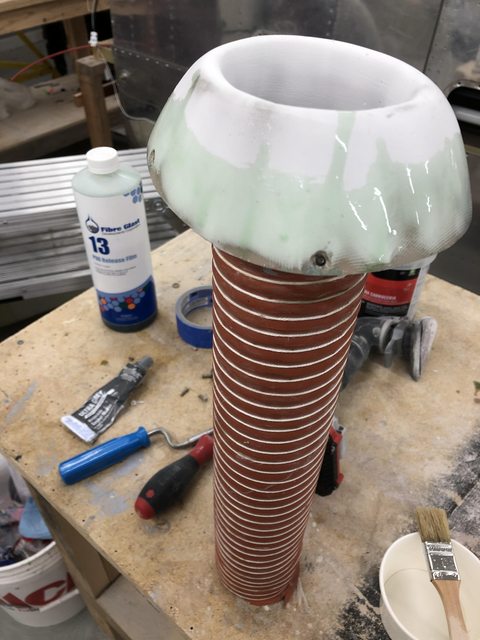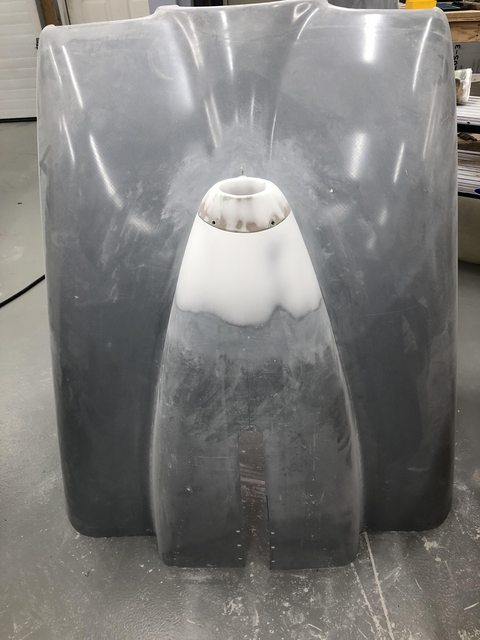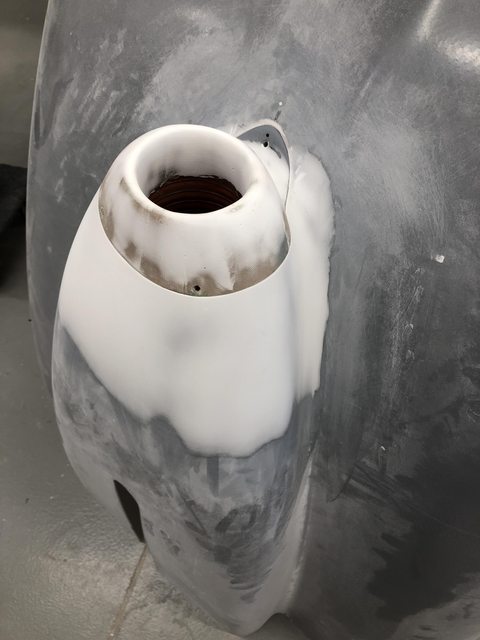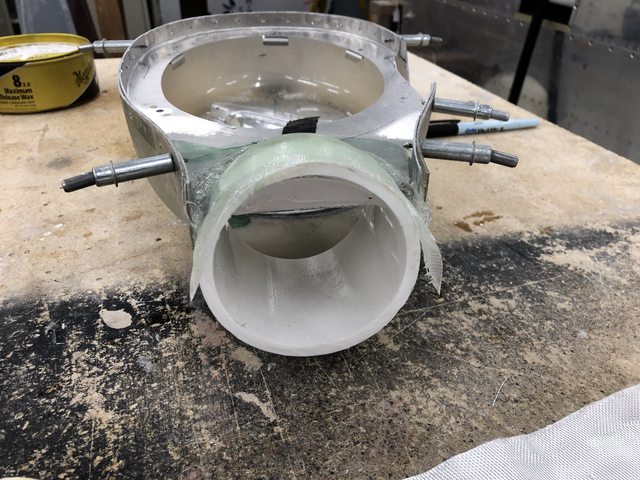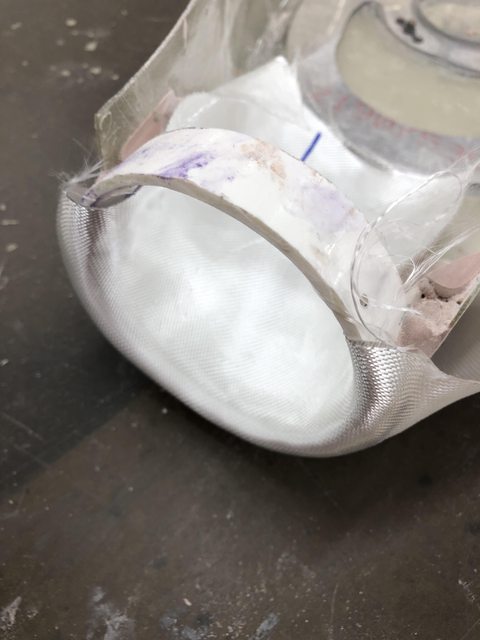I?m no where near ready to make this decision, but I love the look of the 7 or 8 without the scoop. Are there any benefits either way? Does the engine breathe better with the scoop, maybe more ram air? Or are there speed increases from the drag reduction? Does the snorkel in the left intake reduce the airflow into the cowl causing hotter cht?s? Or is the type of induction (Carb vs Injection) dictate which intake the plane goes with?
Van's Air Force
You are using an out of date browser. It may not display this or other websites correctly.
You should upgrade or use an alternative browser.
You should upgrade or use an alternative browser.
Scoop vs snorkel
- Thread starter Taltruda
- Start date
Ed_Wischmeyer
Well Known Member
I asked Van's about that and the loss of ram air pressure is worse than the drag reduction. Scoopless looks better, flies slower.
robertahegy
Moderator/Tech Counselor
Scoop or Snorkel is purely a matter of opinion as far as aesthetics. I sort of like the scoop myself. Either way, it is an RV and has to be BEAUTIFUL.
Roberta


Roberta
Desert Rat
Well Known Member
I don't know the number from vans, but the James cowl has a snorkel and they claim a 1" increase in manifold pressure over ambient at 5,000'.
I?m no where near ready to make this decision, but I love the look of the 7 or 8 without the scoop. Are there any benefits either way? Does the engine breathe better with the scoop, maybe more ram air? Or are there speed increases from the drag reduction? Does the snorkel in the left intake reduce the airflow into the cowl causing hotter cht?s? Or is the type of induction (Carb vs Injection) dictate which intake the plane goes with?
As a practical matter, a snorkel means the cowl is easy to get on and off.
The manifold pressure difference isn't huge. A buyer can do either choice badly or well, shifting the performance balance.
Vertical induction engines (may be carb or injection) almost always use an airbox fed by a forward facing intake. Horizontal induction engines (typically injection) may use either a forward facing intake or the snorkel from the left cooling intake.
JohnInReno
Well Known Member
Snorkel
If you split the scoop intake material so that half is connected to the lower cowl, it makes it much easier to remove the cowl.
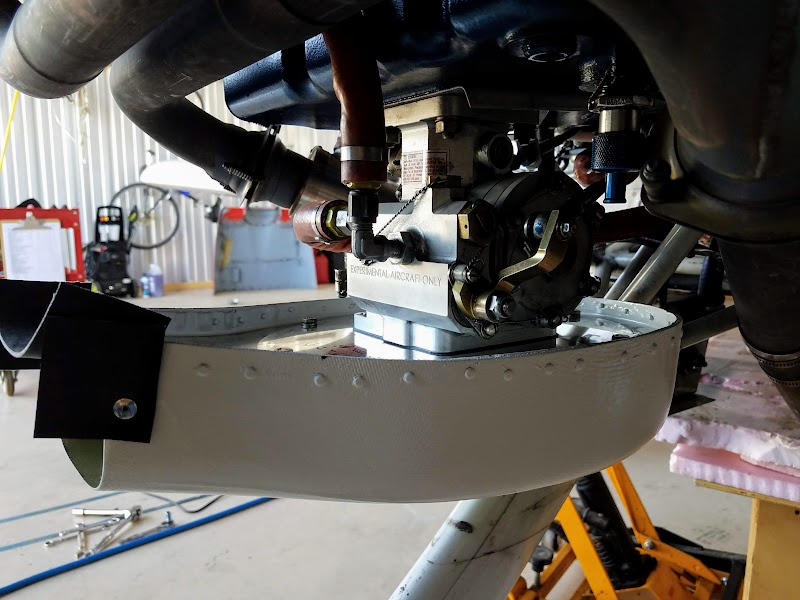
As a practical matter, a snorkel means the cowl is easy to get on and off...
If you split the scoop intake material so that half is connected to the lower cowl, it makes it much easier to remove the cowl.
Last edited:
It relates to induction choice
The snorkel [smooth cowl] is used on fuel injected engines with forward, horizontal mounted fuel servos. The IO-360-M1B & IO-360-A1A are two such engines. Use of a Bendix pressure carb could also use this set up.
Charlie
snipped
Or is the type of induction (Carb vs Injection) dictate which intake the plane goes with?
The snorkel [smooth cowl] is used on fuel injected engines with forward, horizontal mounted fuel servos. The IO-360-M1B & IO-360-A1A are two such engines. Use of a Bendix pressure carb could also use this set up.
Charlie
If you split the snorkel intake material so that half is connected to the lower cowl, it makes it much easier to remove the cowl.
That's an airbox for a vertical induction engine. A snorkel links a horizontal induction to the left cooling air inlet.
As for those seals on the airbox inlet....leakage there pressurizes the lower cowl volume, reducing deltaP, and thus reducing cooling capability. Make sure they seal well.
Forward Facing Data Point
I have an O-320 with carb and the standard Van's cowl with FAB.
During flight testing, I ran the following test.
Climbed to 10,000' MSL. Slowed to minimum controllable airspeed. (Somewhere around 40 KIAS in my airplane.) I read and recorded MAP pressure. I advanced throttle to WOT. I waited. After airspeed stabilized for a few minutes, I read MAP and recorded it.
Back on the ground I calculated that there was 0.5" additional MAP at full speed than there was at slow speed. This is only one data point, one altitude, and one aircraft.
IIRC, there was an RV-7 with an IO-360 200 HP engine that had forward facing ram air inlet, valve, and Van's snorkel that did testing of MAP with both. It was a lot of work to get the valve to not leak so that air flow was one or the other. He reported very little difference in MAP with the two different setups. This was RAM air compared to Van's snorkel. The FAB that Van's sells is a divergent duct and in theory should have a pressure increase as the air flow speed decreases. (The opposite of a venturi where the increase in speed decreases pressure.)
I have an O-320 with carb and the standard Van's cowl with FAB.
During flight testing, I ran the following test.
Climbed to 10,000' MSL. Slowed to minimum controllable airspeed. (Somewhere around 40 KIAS in my airplane.) I read and recorded MAP pressure. I advanced throttle to WOT. I waited. After airspeed stabilized for a few minutes, I read MAP and recorded it.
Back on the ground I calculated that there was 0.5" additional MAP at full speed than there was at slow speed. This is only one data point, one altitude, and one aircraft.
IIRC, there was an RV-7 with an IO-360 200 HP engine that had forward facing ram air inlet, valve, and Van's snorkel that did testing of MAP with both. It was a lot of work to get the valve to not leak so that air flow was one or the other. He reported very little difference in MAP with the two different setups. This was RAM air compared to Van's snorkel. The FAB that Van's sells is a divergent duct and in theory should have a pressure increase as the air flow speed decreases. (The opposite of a venturi where the increase in speed decreases pressure.)
PilotjohnS
Well Known Member
I have YIO360-M1B FI no scoop and I get 21.3 MAP at 9500 and 19.9 MAP at 11500.
At what TAS and RPM?
Bill Boyd
Well Known Member
No mold necessary. Piece was cut from the front snorkel, flange was molded into the cutout opening, cutoff wheel kerf was filled with micro to make a tighter fit. PVC was fitted into the air scoop opening and Bondo'd in, SCAT fitted into the PVC stub with Permatex Ultra gasket silicone on outside of tube. Fiberglass over-wrap on the scoop, down into the throat of the intake, bonding the SCAT on the inside surface. This made the piece thicker that stock, so micro was used to build up the corresponding profile on the lower cowl to equivalent height.
FAB was chopped shorter than standard, more schedule 40 was fitted into the opening and a fiberglass upper transition was molded over clay to complete the transition into the FAB body. More fiberglass to hold the PVC stub in place. Sanded a chamfer on the inner edge of the PVC to give a tapered mouth for the SCAT to plug into in service (under slight longitudinal compression is the plan.) . I have more to do here and will post up pictures when done.
The idea was taken from elsewhere on VAF. Fellow named GregMac.
FAB was chopped shorter than standard, more schedule 40 was fitted into the opening and a fiberglass upper transition was molded over clay to complete the transition into the FAB body. More fiberglass to hold the PVC stub in place. Sanded a chamfer on the inner edge of the PVC to give a tapered mouth for the SCAT to plug into in service (under slight longitudinal compression is the plan.) . I have more to do here and will post up pictures when done.
The idea was taken from elsewhere on VAF. Fellow named GregMac.
Last edited:
NewbRVator
Well Known Member
If you split the scoop intake material so that half is connected to the lower cowl, it makes it much easier to remove the cowl.

That's a great tip. (Fresh on my mind after decowling and recowling today)
I'm thinking it will save me money from the PTSD counseling sessions if I convert soon!!!
I have YIO360-M1B FI no scoop and I get 21.3 MAP at 9500 and 19.9 MAP at 11500.
2400 RPM 165 KTAS
FWIW, here are a couple of data points. RV-8, YIO-360-M1B, 1 Mag & 1 EI, Snorkel, at WOT:
22.0" MP, 2450 RPM, 9500' MSL, 10771' DA, 208 MTAS/181 KTAS.
20.5" MP, 2440 RPM, 11500' MSL, 11985' DA, 205 MTAS/178 KTAS.
Perhaps some manifold pressure calibration is in order. I have assumed standard day temperatures, but...
Steve, at 9500 and 165 KTAS, static pressure is 20.983" Hg and maximum available dynamic pressure is 0.977. Total is 21.96" and you're reporting 21.3", for a difference of 0.66. At 11,500 and 165 KTAS, it's 19.412" plus 0.918, for a total available of 20.33. You report 19.9, so the difference 0.43.
Here's the thing. Manifold pressure is typically measured at the #3 intake port. There is an intake tract pressure loss between the intake at the front of the airplane, and the measurement point at the intake port.
I've measured it; the MP loss for my horizontal intake is 14.4" H2O, or 1.06" Hg, at 2500 ft and WOT, with one pressure tap in the top of the airbox prior to the filter, and the other tee'd into the standard MP line. Some years ago, Don Rivera measured pressure drop for the airbox and filter on his Superflow at about 5" H2O, so the loss for the remainder of the intake tract (throttle body, intake plenum and intake tube) is about 9.4" H2O, or roughly 0.7" Hg.
An M1B has pretty much the same horizontal intake plenum and tube arrangement as the IO-390. Your tract loss should be very similar. The filter loss should be larger, as a standard Vans-supplied K&N filter for a snorkel has less area.
In addition, it is not possible to convert all the available dynamic pressure to static pressure. A good RV cooling setup might capture 0.8 or 0.85 of it at the snorkel inlet. Bad cowling inlets, sloppy baffles, and poor sealing can push it down around 0.6.
So, manifold pressure only 0.66" Hg less than the absolute maximum available seems unlikely. Best case, you lose 0.2" of the available dynamic pressure to a reasonable pressure recovery coefficient, probably 0.4" to the filter, and 0.7" to the intake tract and fuel control. Carl's numbers look even less likely....thus a suggestion of MP instrument error.
Last edited:
JonJay
Well Known Member
The early kits 3,4,6, cowling was geared toward vertical induction.... carb, throttle body, etc.... hence the scoop.
Starting with the 8, then 7, we started to see the shift to horizontal induction, primarily fuel injection. You could do either.
My personal preference is the scoop on the older models, and not on the newer kits, although I think both look good.
At the time, almost twenty years ago, it was a $2k delta to go with the horizontal "cold" air induction, vs vertical induction for the same injected set up.
So, for me, I wanted the scoop for the classic look and saving some $$ was ok too.
"Cold Air Horizontal Induction" was a big buzz back in the day claiming an increase in performance from not heating the induction air as it passed through the sump. Not sure if that is still that case for all HZ induction sumps or not today or how that might affect ones decision to go with a scoop or not.
Starting with the 8, then 7, we started to see the shift to horizontal induction, primarily fuel injection. You could do either.
My personal preference is the scoop on the older models, and not on the newer kits, although I think both look good.
At the time, almost twenty years ago, it was a $2k delta to go with the horizontal "cold" air induction, vs vertical induction for the same injected set up.
So, for me, I wanted the scoop for the classic look and saving some $$ was ok too.
"Cold Air Horizontal Induction" was a big buzz back in the day claiming an increase in performance from not heating the induction air as it passed through the sump. Not sure if that is still that case for all HZ induction sumps or not today or how that might affect ones decision to go with a scoop or not.
Continued...
The traditional quick check of your MP gauge is to set field elevation, note the value in the Kollsman window, and subtract 1" per 1000 feet above sea level. For example, at 08A I'd set 200 feet, then subtract 0.2 from the Kollsman. In theory, if the Kollsman said 29.92, the MP gauge should read 29.72.
Like any rule-of-thumb, it's not super accurate, just close. The answer will be as much as 0.1" Hg too high below 6000 feet, and could be worse if your altimeter is out of calibration.
I dug around a bit this afternoon. Here's a simple web calculator which will work on your phone, at the airport. Seems to be pretty accurate.
http://www.csgnetwork.com/stationpressurecalc.html
Input the altimeter setting from your best local source and the altitude where your airplane is parked. Tap calculate, and compare "station pressure" to your MP gauge, engine off. The calibration risk is the accuracy of your local FAA equipment.
The traditional quick check of your MP gauge is to set field elevation, note the value in the Kollsman window, and subtract 1" per 1000 feet above sea level. For example, at 08A I'd set 200 feet, then subtract 0.2 from the Kollsman. In theory, if the Kollsman said 29.92, the MP gauge should read 29.72.
Like any rule-of-thumb, it's not super accurate, just close. The answer will be as much as 0.1" Hg too high below 6000 feet, and could be worse if your altimeter is out of calibration.
I dug around a bit this afternoon. Here's a simple web calculator which will work on your phone, at the airport. Seems to be pretty accurate.
http://www.csgnetwork.com/stationpressurecalc.html
Input the altimeter setting from your best local source and the altitude where your airplane is parked. Tap calculate, and compare "station pressure" to your MP gauge, engine off. The calibration risk is the accuracy of your local FAA equipment.
Last edited:
I checked my (Dynon) MAP sensor today. It reads high by 0.45" HG. That is bigger error than I would have expected.
So I reduced the MAP values in Post #17 by the 0.45" HG delta, but the numbers still seem a bit high, based on your comments in Post #19.
Here are the revised data points. RV-8, YIO-360-M1B, 1 Mag & 1 EI, Snorkel, at WOT:
21.5" MP, 2450 RPM, 9500' MSL, 10771' DA, 208 MTAS/181 KTAS.
20.0" MP, 2440 RPM, 11500' MSL, 11985' DA, 205 MTAS/178 KTAS.
Yes. Still too high. Why? Hmm. Maybe I'm missing something here.
(Review intake tract data)
Duh...I was sloppy. Sorry.
The 1.06" Hg (14.4" H2O) tract loss quoted previously (deltaP, airbox prior to filter vs MP at #3 primer port) was a value for 2500, WOT, derived (as a cross check) from two other deltas. However, I also measured the airbox/MP deltaP directly, at three different altitudes....and tract loss decreases with altitude. That detail would close some of the gap.
Here's a link to the original spreadsheet record:
https://www.danhorton.net/VAF/Scoop vs Snorkel/
Note Line 31. It's what I grabbed in a hurry while slopping down some coffee before work.
Now look at Line 18, the measured tract pressure loss for three altitudes.
Extrapolate from the 6500 and 10500 loss, and tract loss is roughly 9.2" H2O at 9500 and 8.4" H2O at 11500. That's 0.68" Hg and 0.62" Hg.
9500 ft static is 20.98..call it 21.0. Factoring density, Q is 1.13. 80% of Q is 0.9. 21.0 plus 0.9 = 21.9. 21.9 less a tract loss (mine, not yours) of 0.68 is an estimated MP of 21.2. You're reporting 21.5. Difference is 0.3" Hg
11500 ft static is 19.41..call it 19.4. Factoring density, Q is 1.05. 80% of Q is 0.8. 19.4 plus 0.8 = 20.2. 20.2 less a tract loss of 0.62 is an estimated MP 19.58. You're reporting 20.0. Difference is 0.42".
Right now I don't have an explanation for why you're still higher than the estimates. There are quite a few variables. That said, your new corrected MP's are a lot closer to reality, as are Steve's.
Steve, had a chance to check calibration?
BTW, as a reality check on the estimates, here are panel shots from a trip to PA last week. Note these MP figures are for a horizontal ram airbox, not a snorkel.
9500, peak EGT, WOT. Static would be 21.0 Including adjustment for 23F above standard, recovered Q would be 1.174 x 75% = 0.88 (the 75% is computed from the spreadsheet). The total before the filter is thus 21.88". The tract loss was 0.68", so the estimated MP would be 21.2". I'm actually showing 21.3, pretty close.
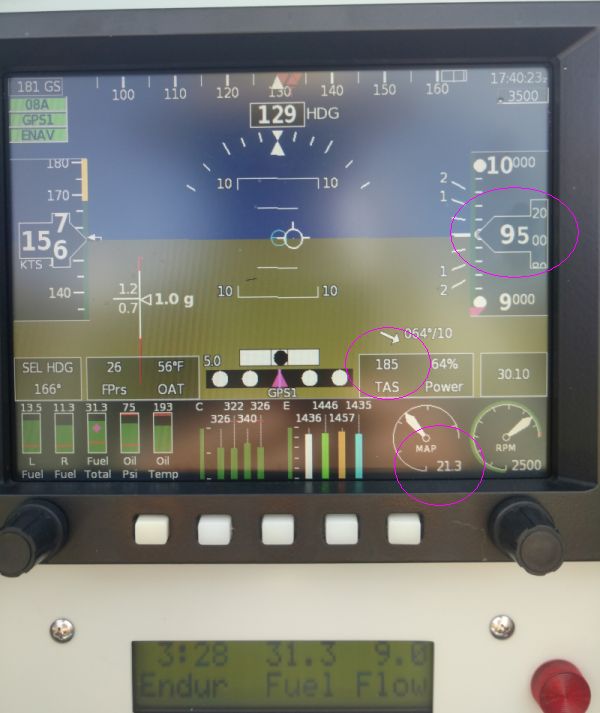
11500, 60 LOP, WOT. I show 19.5" at 180 KTAS. Static would be 19.41. Including adjustment for 30F above standard, recovered Q would be 1.03 x 75% = 0.77". The total before the filter is thus 20.18". The tract loss was 0.62, so the estimated MP would be 20.18 total less 0.62" tract loss = 19.56" I'm showing 19.5"
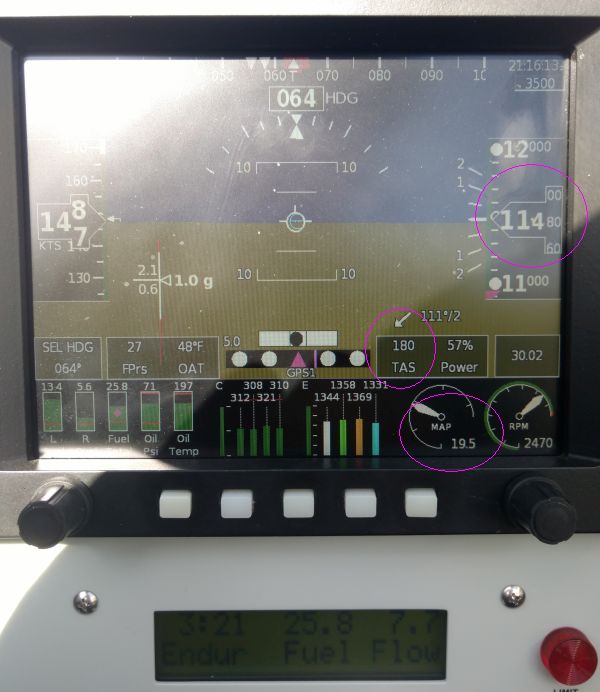
Last edited:
Thought about it, poked around in some papers. Let's assume Carl and Steve are reporting very accurate manifold pressure. That being the case, why would MP be higher than the estimates I provided? The obvious answer is one of the inputs to my estimates is wrong. The most likely potential culprit is the discount I've applied to Q, dynamic pressure. For both estimates I factored Q by 0.8, because for a good cowl, it's a reasonable estimate of Cp, coefficient of pressure, as defined in CR3405:
Cp = (local pressure at measurement point less freestream pressure) / available dynamic pressure
For example, if average plenum pressure is measured at 21.8, freestream pressure is 21.0, and available Q is 1.0, we would have:
Cp = (21.8 - 21) / 1 = 0.8
A factor of 1.0 (full dynamic pressure available at the face of snorkel filter) would add about 0.2" Hg to the snorkel estimate, bringing it closer to what Carl and Steve report. Is it possible?
Answer is maybe. The 0.8 factor is based on average plenum pressure. However, in reality the upper cowl pressure varies a bit depending on exactly where it is measured.
This is an upper cowl pressure survey from CR3405. Cp is as noted above. Note that in the low AOA cruise condition, Cp approaches or even exceeds 1.0 within the intake passage, right where the snorkel filter is located.
(Side note...the very good Cp in the climb condition reflects how well a large outboard inlet can harvest the dynamic pressure in propeller outflow.)
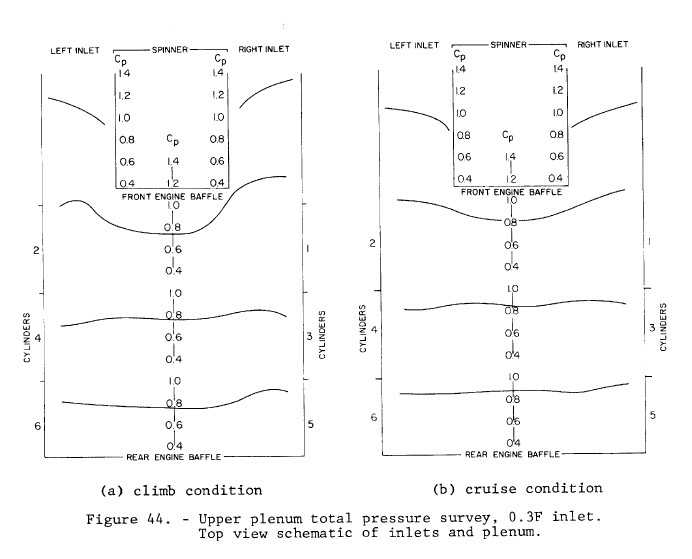
Returning to our OP's question (which is better, snorkel or scoop?), what we have here is a suggestion that a snorkel can outperform a horizontal ram. It's only a suggestion, because it rides on data taken with a cooling inlet unlike the stock Vans cowl inlet. If someone would like to actually measure static pressure at the face of a snorkel filter, I would be happy to help. Obviously I find this stuff interesting
Cp = (local pressure at measurement point less freestream pressure) / available dynamic pressure
For example, if average plenum pressure is measured at 21.8, freestream pressure is 21.0, and available Q is 1.0, we would have:
Cp = (21.8 - 21) / 1 = 0.8
A factor of 1.0 (full dynamic pressure available at the face of snorkel filter) would add about 0.2" Hg to the snorkel estimate, bringing it closer to what Carl and Steve report. Is it possible?
Answer is maybe. The 0.8 factor is based on average plenum pressure. However, in reality the upper cowl pressure varies a bit depending on exactly where it is measured.
This is an upper cowl pressure survey from CR3405. Cp is as noted above. Note that in the low AOA cruise condition, Cp approaches or even exceeds 1.0 within the intake passage, right where the snorkel filter is located.
(Side note...the very good Cp in the climb condition reflects how well a large outboard inlet can harvest the dynamic pressure in propeller outflow.)

Returning to our OP's question (which is better, snorkel or scoop?), what we have here is a suggestion that a snorkel can outperform a horizontal ram. It's only a suggestion, because it rides on data taken with a cooling inlet unlike the stock Vans cowl inlet. If someone would like to actually measure static pressure at the face of a snorkel filter, I would be happy to help. Obviously I find this stuff interesting
Last edited:
Dan...
I’m the same MP as you at 9500. A little higher at 11,500. Not sure why my KTAS is only 165 to your 185? What engine and prop do you have? I know the 8 is a little faster than a 7 but dang you are smoking...
The same MP at the same altitude (assuming the same OAT), again suggests your reported MP is either (1) too high for reality, or (2) the snorkel's inlet location in the left cooling air ramp has a higher Cp. (see previous post).
Why? Available dynamic pressure is a function of density and velocity squared. You simply don't have as much dynamic pressure available at 165 KTAS as I do at 185 KTAS. In order to show the same MP, your gauge would be wrong, or you're capturing a higher percentage of the available dynamic pressure.
To be realistic, there some other possibilities, but first we should confirm or deny the pressures available with the snorkel.
My RV-8 has a 390, a tip-over fastback bubble, and some cooling drag reductions. In recent years my interest has been less about top speed, and more about tweaking for cheap cruise without losing much TAS. In the context of this thread, readers should note that it has a horizontal ram intake; a 4" dia inlet ring leading into an airbox with a large area filter, then an FM200. The rest of the intake tract (I think) is nearly identical to the M1B parallel valve engines you and Carl are flying. We should confirm that detail, as it may have an effect on tract pressure loss between the throttle and the intake valve.
Last edited:
Carl & Steve,
You might want to read the thread linked below to learn more about some of the mods Dan has made to his 8s FWF. See
http://www.vansairforce.com/community/showthread.php?t=173899
Charlie
You might want to read the thread linked below to learn more about some of the mods Dan has made to his 8s FWF. See
http://www.vansairforce.com/community/showthread.php?t=173899
Charlie
BillL
Well Known Member
Actual numbers, all fun
As a data point,
10038' AltB, 8.1C OAT (+23.4F) 159 KTAS (yes, it is slow)
Ambient from Chart = 20.55 in-Hg absolute
Dynamic pressure = .8642 in-Hg
MAP from G3x = 20.7 in-hg
Pressure drop = .71 in-Hg or 9.72 in-H2O
Note: MAP not calibrated with static ambient . . . . yet.
As a data point,
10038' AltB, 8.1C OAT (+23.4F) 159 KTAS (yes, it is slow)
Ambient from Chart = 20.55 in-Hg absolute
Dynamic pressure = .8642 in-Hg
MAP from G3x = 20.7 in-hg
Pressure drop = .71 in-Hg or 9.72 in-H2O
Note: MAP not calibrated with static ambient . . . . yet.



